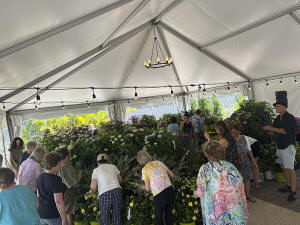Living fences. Leaves with holes. A lived-in vibe. And other likely
garden trends for 2025
 Send a link to a friend
Send a link to a friend
 [January 03, 2025]
By JESSICA DAMIANO [January 03, 2025]
By JESSICA DAMIANO
What will our gardens look like in 2025? The thing about opinions is
that everybody’s got one. The same can be said about predictions.
One group with a pretty good track record is Katie Dubow's Garden Media
Group, a public-relations company serving plant breeders, nurseries and
others in the green industry. Its annual Garden Trends Report forecasts
how environmental, fashion, food, retail, media and other trends will
trickle down into the gardening realm.
In 2006, GMG foresaw the beginning of the native plants movement; in
2009, it predicted a surge in vertical gardening; and in 2018, the
mainstreaming of forest bathing.
So, what’s in store for gardeners this year? I talked with Dubow and
other experts:
Living Fences
In the U.S., 84% of newly built single-family homes sold in 2022 were
part of a Homeowners’ Association, according to the U.S. Census Bureau.
So, it follows that Dubow foresees more homeowners trying to
differentiate their HOA properties from their neighbors’ without running
afoul of the rules.
Planting living fences that incorporate various plant types, including
native species that support wildlife, will impart an eco-conscious
individuality to cookie-cutter property borders.

Foraging
Floral foraging is another naturalistic trend predicted for next year.
That means going into your garden or into the wild to gather shrub and
tree branches, stems and flowers, and using whatever you find outside to
create something beautiful to bring inside.
“People are craving a connection to nature,” Dubow said, “and foraging
helps them do that.”
Most people don’t have designated raised-bed cutting gardens, said Megan
McMullen, learning and development manager of Homestead Gardens, which
has three store locations in Maryland and Delaware. “But they do have
landscaped garden spaces, and we wanted to help them think about those
spaces in (untraditional) ways,” she said.
So, over the past year, the nursery offered customers a series of
foraging workshops, during which participants learned how to select wild
elements and prune shrub parts to use in homemade bouquets.
To ensure a steady supply of foraging materials, McMullen recommends
giving careful thought to interesting year-round elements like seedpods,
cones and twigs when selecting garden plants, rather than just planting
for summer flowers and foliage.
“There was a lot of interest for something that’s a new-ish garden
trend,” McMullen said. “It was the right time to be talking about this
because people are starting to think about it.”

[to top of second column]
|

This image provided by Homestead Gardens shows attendees
participating in a foraging workshop at the garden center's
Davidsonville, M.D., location on June 8, 2024. (Megan
McMullen/Homestead Gardens via AP)
 Tyrannical cuteness
Citing the prevalence of unnatural scenes created by artificial
intelligence, coupled with a Pinterest trend toward “tyrannical
cuteness,” Dubow predicts a preference among home gardeners for
plants with “never-before-seen colorations” and “surreal pastels” as
they attempt to replicate those over-the-top, “cute” AI images at
home.
One example is the genetically engineered Firefly bioluminescent
petunia, which glows in the dark. Introduced earlier this year by
the biotechnology firm Light Bio of Sun Valley, Idaho, the effect
was created by inserting genes from luminous mushroom into a petunia
plant.
It follows that whimsical plants that appear to have emerged from
the pages of a Dr. Seuss book, like alliums, cardoons and sea holly,
may also grow in popularity.
Fairy gardens may see a resurgence, as well, Dubow said.
Lived-in gardens
A $600 pair of dirty-looking Golden Goose sneakers. A $3,800
Balenciaga “worn and aged” concert wristband bracelet. And a report
that vintage Rolexes are outselling new ones. What do these cultural
trends imply?
“They show us that people want the idea of something that’s had a
lifetime,” Dubow said. And a typical pristine, symmetrical landscape
doesn’t provide that.
Next year, she predicts a move toward “lived-in gardens” with
rambling roses, bulb lawns, native plants, mature trees and densely
planted, layered garden beds.

Holy Moley plants
Finally, Dubow draws a parallel between the celebrity “cutout” dress
fashion trend and fenestrated plants --- those with holes in their
leaves, like split-leaf Philodendron and Monstera. Although those
plants have been wildly popular for the better part of a decade, she
cited a 600% increase in Google Trend searches for Monstera in the
first half of 2024.
But I have to ask: Is this plants imitating life or life imitating
plants?
___
Jessica Damiano writes weekly gardening columns for the AP and
publishes the award-winning Weekly Dirt Newsletter. You can sign up
here for weekly gardening tips and advice.
All contents © copyright 2024 Associated Press. All rights reserved |